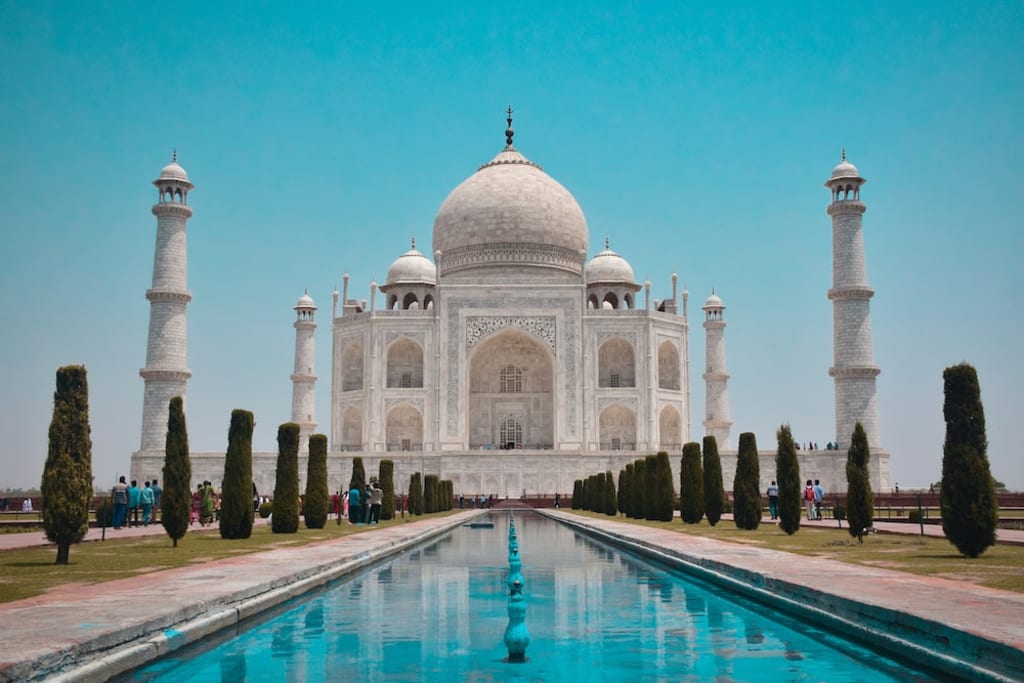The Romantic, Heartbreaking Love Story Behind the Taj Mahal
A Majestic City Carved into Rock, Thousands of Years Ago.

The love story of Shah Jahan, the Mughal emperor of India, and Mumtaz Mahal is one of the most famous and romantic tales in history. It is primarily known for the construction of the Taj Mahal, a magnificent white marble mausoleum, which is considered one of the most beautiful buildings in the world and a symbol of enduring love.
Shah Jahan, whose birth name was Prince Khurram, was born in 1592. He was the son of Emperor Jahangir and a Rajput princess, Princess Manmati. In 1607, at the age of 14, he met a young Persian noblewoman named Arjumand Banu Begum, who would later become famous as Mumtaz Mahal. They fell deeply in love, and their relationship grew stronger over the years.
In 1612, Khurram married Mumtaz Mahal, and she became his favorite wife. They had a loving and harmonious marriage, and Mumtaz was not only Shah Jahan's beloved wife but also his trusted companion and advisor. She accompanied him on military campaigns and played an active role in court politics.
Tragically, in 1631, while giving birth to their 14th child, Mumtaz Mahal died at the age of 38. Shah Jahan was devastated by her death and entered a period of mourning. He decided to build a grand mausoleum in her memory, which would later become the Taj Mahal. Construction of the Taj Mahal began in 1632 and took over 20 years to complete, with thousands of artisans and laborers working tirelessly to bring Shah Jahan's vision to life.
The Taj Mahal is a masterpiece of Mughal architecture, known for its stunning white marble facade adorned with intricate carvings and inlaid gemstones. Inside the mausoleum, Mumtaz Mahal's tomb lies beside Shah Jahan's, symbolizing their eternal love. The Taj Mahal is surrounded by beautiful gardens and is considered one of the most iconic symbols of love and architectural beauty in the world.
Shah Jahan continued to rule the Mughal Empire until 1658 when his son Aurangzeb seized power and imprisoned his father in Agra Fort, where Shah Jahan could gaze at the Taj Mahal in the distance until his death in 1666.
The love story of Shah Jahan and Mumtaz Mahal is a testament to the enduring power of love and the incredible beauty that can be created in its name. The Taj Mahal stands as a remarkable monument to their love and remains one of the most visited and admired landmarks in the world.
The construction of the Taj Mahal, one of the most iconic monuments in the world, is a testament to the skill and artistry of Mughal architecture. Here's an overview of the construction process of the Taj Mahal:
Planning and Design: The idea to build the Taj Mahal came from Shah Jahan himself, after the death of his beloved wife, Mumtaz Mahal, in 1631. He wanted to create a grand and beautiful mausoleum in her memory. The design of the Taj Mahal is attributed to the chief architect, Ustad Ahmad Lahori, and it is said to be inspired by Persian and Mughal architectural styles.
Site Selection: The site selected for the Taj Mahal was on the southern bank of the Yamuna River in Agra, India. This location provided a picturesque backdrop for the monument.
Construction Materials: The primary building material used for the Taj Mahal is white marble, which was quarried from the nearby Makrana quarries in Rajasthan. Other materials, including red sandstone and various precious and semi-precious stones, were sourced from different regions of India and Asia.
Construction Workforce: The construction of the Taj Mahal involved the labor of thousands of skilled artisans, stonemasons, and laborers. Skilled craftsmen and artists from various parts of the Mughal Empire and beyond were brought in to work on the project.
Foundation and Structure: Construction began in 1632, and the foundation was laid using wooden framework and wells to dig and fill with stone and rubble. The main structure consists of a central white marble dome surrounded by four smaller domes and four minarets at the corners. The entire complex is symmetrical and meticulously designed.
Intricate Inlay Work: One of the most remarkable features of the Taj Mahal is its intricate inlay work. Precious and semi-precious stones, such as lapis lazuli, turquoise, coral, onyx, and mother-of-pearl, were used to create delicate floral and geometric designs on the marble surfaces. This process is known as "pietra dura."
Landscaping: The Taj Mahal is set within a well-designed garden with a large reflecting pool in front of it. The garden is divided into four quadrants, each with raised pathways and fountains. The garden represents the paradise described in Islamic literature.
Completion: The construction of the Taj Mahal took over 20 years to complete. It is estimated that it was finished around 1653.
Purpose and Symbolism: The Taj Mahal was built as a mausoleum for Mumtaz Mahal, the favorite wife of Shah Jahan, who died during childbirth. It serves as a symbol of eternal love and is considered one of the most romantic monuments in the world.
The Taj Mahal is not only a testament to the architectural and artistic achievements of the Mughal Empire but also a symbol of enduring love. It has been recognized as a UNESCO World Heritage Site and continues to attract millions of visitors from around the world who come to admire its beauty and learn about its history.
About the Creator
Gopalakrishna Chowdary
A strong storyteller.





Comments
There are no comments for this story
Be the first to respond and start the conversation.